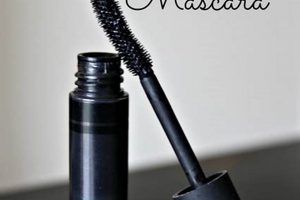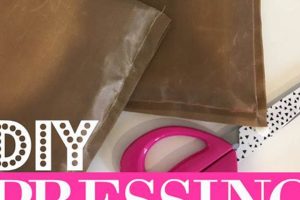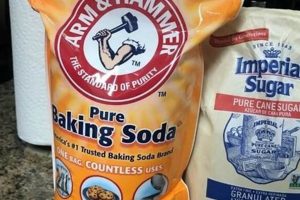Formulations created at home for the purpose of washing and sanitizing flooring surfaces fall under the category of homemade floor cleaners. These preparations typically utilize readily available household ingredients, such as vinegar, baking soda, dish soap, and essential oils, combined with water to produce a cleaning agent. As an example, a mixture of white vinegar and water can serve as an effective solution for cleaning hardwood or tile floors.
The appeal of these approaches lies in their cost-effectiveness, environmental friendliness, and control over the ingredients used. Selecting this method can reduce reliance on commercially manufactured products containing potentially harsh chemicals. Historically, such methods were commonplace before the widespread availability of pre-packaged cleaning supplies, and they continue to be valued for their simplicity and customizable nature.
The following sections will explore various recipes suitable for different floor types, address safety considerations when formulating these mixtures, and examine their efficacy compared to commercially available alternatives. Furthermore, the discussion will encompass proper application techniques and long-term storage guidelines to ensure optimal results and user safety.
Tips for Effective Homemade Floor Care
The following guidance ensures optimal results and user safety when employing self-prepared floor cleansers. Adherence to these recommendations maximizes cleaning efficacy and minimizes potential damage to flooring surfaces.
Tip 1: Prioritize Surface Compatibility: Different flooring materials require specific cleaning agents. Verify that the selected mixture is appropriate for the intended surface (e.g., hardwood, tile, laminate) to prevent discoloration, warping, or other forms of damage. Spot test in an inconspicuous area before full application.
Tip 2: Dilute Concentrated Solutions: Concentrated cleaning agents, even those formulated from household ingredients, can be abrasive or leave residue. Adhere to recommended dilution ratios to maintain cleaning power while minimizing potential harm. A general guideline is to start with a weaker solution and increase concentration as needed.
Tip 3: Employ Microfiber Mops and Cloths: Microfiber materials are highly effective at trapping dirt and debris, reducing the need for excessive scrubbing. Their non-abrasive nature minimizes the risk of scratching delicate flooring surfaces. Regularly rinse and wring out the mop or cloth during the cleaning process.
Tip 4: Control Moisture Levels: Excessive moisture can penetrate and damage certain floor types, particularly hardwood. Wring out mops thoroughly and promptly dry any standing water to prevent warping, swelling, or mold growth.
Tip 5: Rinse After Cleaning: While not always necessary, rinsing the floor with clean water after applying a homemade cleaning solution can remove any remaining residue. This is especially important for surfaces prone to streaking or dulling.
Tip 6: Store Properly Labeled Mixtures: When storing these solutions for later use, clearly label the container with the contents and date of preparation. This prevents accidental misuse or confusion with other household liquids. Store in a cool, dark place away from children and pets.
Tip 7: Understand Ingredient Interactions: While most common household ingredients are safe for cleaning, some combinations can produce hazardous fumes. Never mix bleach with ammonia or vinegar, as these combinations release toxic gases. Adhere to safe mixing practices.
By following these tips, users can effectively and safely maintain clean and healthy floors using environmentally conscious, homemade cleaning alternatives.
The subsequent section addresses specific recipes and formulations tailored for various flooring types.
1. Ingredient safety
The safety profile of ingredients used in homemade floor cleansers directly influences the health and well-being of individuals occupying the cleaned space and the integrity of the floor itself. Inadequate attention to ingredient safety can lead to adverse health effects, such as skin irritation, respiratory distress, or chemical burns, especially with prolonged exposure or improper handling. For example, the unintended combination of vinegar and bleach, while both common household substances, generates chlorine gas, a potent respiratory irritant.
Moreover, certain ingredients, though ostensibly benign, may react unfavorably with specific flooring materials. The use of undiluted lemon juice on marble, for instance, can etch the surface due to its acidic nature, resulting in permanent damage. Conversely, utilizing milder, pH-neutral components, like castile soap, often presents a safer cleaning alternative for delicate surfaces, minimizing the risk of degradation. A clear understanding of each ingredient’s properties and potential interactions is paramount in formulating a secure and effective homemade floor cleaning solution.
Therefore, prioritizing ingredient safety within the creation of homemade floor cleaners extends beyond mere precaution; it is a fundamental element ensuring both human and material well-being. The absence of this consideration introduces avoidable risks, undermining the very purpose of creating a homemade solution a cost-effective, eco-conscious, and safe cleaning method. Accurate knowledge of chemical properties and potential interactions allows for responsible formulation and application.
2. Surface Compatibility
Surface compatibility is a critical determinant in the successful application of any homemade floor cleanser. The effect of an incompatible solution can range from superficial cosmetic damage to irreversible structural degradation of the flooring material. The composition of diverse flooring materials, such as hardwood, laminate, tile, and natural stone, necessitates customized cleaning formulations. A highly acidic solution, appropriate for removing grout stains on ceramic tile, would prove detrimental to the finish of a hardwood floor, resulting in discoloration, etching, or warping. The inherent porous nature of some stones, like marble, further exacerbates the risks associated with inappropriate cleaning agents, leading to absorption and staining.
Understanding the specific characteristics of the flooring is, therefore, not merely a best practice but a prerequisite for formulating a safe and effective homemade cleaning solution. Failure to assess compatibility introduces a significant risk of compromising the floor’s integrity, potentially necessitating costly repairs or replacement. For instance, using an ammonia-based cleaner on waxed floors would strip the wax, leaving the surface unprotected and susceptible to further damage. Conversely, a pH-neutral solution is generally safer for sensitive materials, but may lack the necessary strength to
address more stubborn stains on resilient flooring like vinyl.
In summary, surface compatibility directly dictates the viability and longevity of the flooring under maintenance with homemade solutions. Prior assessment and informed selection of cleaning agents are essential. Neglecting this aspect undermines the intended benefits of opting for a cost-effective and environmentally conscious approach, potentially leading to unintended consequences. Effective DIY floor cleaning demands a clear understanding of the chemical properties of both the cleaning solution and the floor material.
3. Mixing ratios
In the realm of homemade floor cleansers, precise mixing ratios constitute a cornerstone of both efficacy and safety. Deviation from established proportions can compromise cleaning effectiveness or, more seriously, lead to damage to the flooring material or pose health risks to individuals within the environment.
- Concentration and Cleaning Power
The concentration of active cleaning agents, such as vinegar or essential oils, directly impacts the solution’s ability to lift dirt, grease, and grime. Insufficient concentration yields a weak cleaner, requiring excessive scrubbing and failing to effectively sanitize surfaces. Conversely, overly concentrated solutions may leave behind a sticky residue or, in the case of acidic components, etch or discolor sensitive flooring like marble or hardwood.
- Balancing Ingredients for Stability
Many homemade solutions involve combining multiple ingredients with differing chemical properties. Adherence to specific ratios ensures the stability of the mixture and prevents undesirable reactions. For instance, combining baking soda and vinegar in excessive quantities can lead to a rapid release of carbon dioxide, potentially causing pressure buildup in a closed container and negating the cleaning effects.
- Surface Material Compatibility
The optimal mixing ratio is intrinsically linked to the flooring material’s sensitivity to specific cleaning agents. Hardwood floors, prone to water damage and finish degradation, necessitate diluted solutions with minimal water content. Conversely, ceramic tile, more resistant to moisture and chemical exposure, can tolerate more concentrated cleansers, particularly when targeting stubborn grout stains. Ignoring these material-specific requirements can lead to irreversible damage.
- Minimizing Residue and Rinsing Requirements
Proper mixing ratios minimize the likelihood of leaving behind a residue that attracts dirt or dulls the floor’s finish. Overuse of soap or other surfactants requires thorough rinsing with clean water to prevent buildup. Accurate proportions contribute to a self-rinsing effect, reducing the labor and time involved in achieving a clean and streak-free surface.
In conclusion, the formulation of effective homemade floor cleansers is predicated on a thorough understanding of appropriate mixing ratios. These ratios directly influence cleaning power, ingredient stability, surface material compatibility, and the potential for residue buildup. By meticulously adhering to recommended proportions, users can maximize the benefits of this solution namely, cost-effectiveness, environmental friendliness, and control over ingredients while minimizing the risks associated with improper use.
4. Residue management
Residue management represents a critical aspect in the successful application of any homemade floor cleaning solution. The effectiveness and longevity of the cleaning process hinge significantly on the composition of the solution and the techniques employed to minimize residue accumulation. Improper residue management can negate the benefits of a homemade cleaner, leading to diminished floor appearance, increased dirt attraction, and potential damage over time.
- Concentration Control and Formulation Balance
Precise control over ingredient concentrations and the overall balance of the formulation is paramount in minimizing residue. Overly concentrated solutions, even those containing natural ingredients, may leave behind a film or sticky texture. This residue attracts dirt, diminishing the floor’s cleanliness and requiring more frequent cleaning cycles. For example, excessive use of oil-based ingredients, while effective for cleaning, can result in a greasy residue that is difficult to remove. The formulation must be balanced to ensure effective cleaning without excessive deposition of ingredients.
- Rinsing Practices and Water Hardness
Rinsing practices significantly impact residue management. Certain homemade solutions, particularly those containing soap-based components, necessitate a thorough rinsing step with clean water. The hardness of the water used for rinsing also plays a crucial role. Hard water, containing high mineral content, can react with cleaning agents to form insoluble residues, contributing to dullness and streaking. The use of distilled or softened water for rinsing can mitigate these effects.
- Application Techniques and Equipment Selection
The techniques used to apply the cleaning solution and the equipment employed influence residue deposition. Over-saturation of the floor during the cleaning process increases the potential for residue buildup. Using a damp mop rather than a soaking wet one minimizes this risk. Microfiber mops are preferable to traditional cotton mops due to their superior ability to lift dirt and cleaning solution without leaving behind fibers or excess moisture.
- Maintenance Frequency and Long-Term Effects
The frequency of cleaning and the long-term effects of repeated application of homemade solutions directly correlate with residue accumulation. Infrequent cleaning allows residue to accumulate, making subsequent cleaning cycles less effective. Conversely, overly frequent cleaning with harsh solutions can strip away protective finishes, increasing the floor’s susceptibility to damage. A balanced cleaning schedule, tailored to the floor type and traffic levels, is essential for effective residue management.
In summation, effective residue management is integral to the successful implementation of homemade floor cleaning solutions. The interplay between formulation, rinsing practices, application techniques, and maintenance frequency determines the long-term cleanliness, appearance, and integrity of the flooring. Neglecting residue management can undermine the benefits of a homemade approach, leading to counterproductive results.
5. Environmental impact
The selection of floor cleaning methods directly influences environmental sustainability. Homemade solutions present an alternative to commercially manufactured products, and their environmental impact warrants careful consideration.
- Reduced Chemical Waste
Commercial floor cleaners often contain synthetic chemicals that contribute to water pollution when discharged through wastewater systems. Self-prepared solutions, utilizing ingredients such as vinegar, baking soda, and citrus peels, minimize the introduction of synt
hetic compounds into the environment. These biodegradable materials decompose more readily, reducing the burden on wastewater treatment facilities. An example would be the reduction in phosphates entering waterways, which are often found in commercial cleaners and contribute to eutrophication. - Lower Carbon Footprint
The manufacturing, packaging, and transportation of commercial cleaning products contribute to greenhouse gas emissions. The creation of homemade alternatives generally requires fewer resources and reduces the demand for energy-intensive manufacturing processes. Sourcing ingredients locally can further reduce the carbon footprint associated with floor cleaning. For instance, using vinegar produced within a region minimizes the transportation emissions compared to purchasing a commercially produced cleaner shipped from a distant location.
- Minimized Plastic Packaging
Commercial cleaning products are typically packaged in single-use plastic containers that contribute to plastic waste accumulation. Formulating cleaning solutions reduces the need for these containers, decreasing plastic pollution. Reusing existing containers for storing homemade cleaners further diminishes plastic consumption. An example would be refilling a glass spray bottle with a homemade solution rather than purchasing a new plastic bottle of commercial cleaner.
- Reduced Exposure to Harmful Chemicals
Commercial floor cleaners often contain volatile organic compounds (VOCs) and other potentially harmful chemicals that can negatively impact indoor air quality and human health. DIY formulations offer greater control over ingredients, allowing users to avoid known allergens and toxins. For instance, opting for essential oils for fragrance instead of synthetic fragrances eliminates exposure to phthalates, which are commonly found in commercial cleaners and can disrupt endocrine function.
In summary, the environmental impact of utilizing self-prepared floor cleaning solutions is multifaceted. Reduced chemical waste, a lower carbon footprint, minimized plastic packaging, and reduced exposure to harmful chemicals are potential benefits. Choosing this method can contribute to more sustainable practices. However, responsible sourcing of ingredients and proper disposal methods are still essential to maximize environmental benefits.
Frequently Asked Questions
The following section addresses common inquiries regarding the preparation and application of homemade floor cleansers. These questions aim to clarify misconceptions and provide guidance on best practices.
Question 1: How does one determine the appropriate concentration of vinegar in a homemade floor cleaning solution?
The concentration of vinegar depends on the floor type. For sealed hardwood, a solution of one-half cup of white vinegar per gallon of water is recommended. For tile or linoleum, the concentration can be increased to one cup per gallon. A spot test is advised to assess compatibility.
Question 2: What are the potential risks associated with combining baking soda and vinegar in a floor cleaning mixture?
Combining baking soda and vinegar produces carbon dioxide, which can cause pressure buildup in closed containers. While this combination is effective for unclogging drains, it is less effective for floor cleaning as the resulting solution is mostly water and salt. The effervescence dissipates the cleaning power.
Question 3: Is it safe to use essential oils in floor cleaning solutions, particularly around pets?
While many essential oils possess antimicrobial properties, some can be toxic to pets. Tea tree oil, for example, is highly toxic to cats and dogs. It is imperative to research the safety of each essential oil before using it in a cleaning solution and to ensure adequate ventilation when applying.
Question 4: How does water hardness affect the efficacy of homemade floor cleaning solutions?
Hard water contains minerals that can react with soap-based cleaning agents, forming a residue. This residue can dull the floor’s finish and reduce the cleaning effectiveness. Using distilled or softened water can mitigate these effects and improve cleaning performance.
Question 5: What is the recommended method for storing unused homemade floor cleaning solutions?
Unused solutions should be stored in clearly labeled containers, away from direct sunlight and extreme temperatures. The container should be airtight to prevent evaporation or contamination. Solutions containing perishable ingredients, such as citrus peels, should be refrigerated and used within a week.
Question 6: How can one ensure that a homemade floor cleaning solution effectively disinfects surfaces?
While some ingredients, like vinegar, possess mild antimicrobial properties, they may not provide the same level of disinfection as commercial disinfectants. For enhanced disinfection, consider adding a small amount of hydrogen peroxide (3%) to the solution. However, exercise caution and perform a spot test to prevent bleaching or damage to the flooring.
Key takeaways from this FAQ section include the importance of surface compatibility, proper ingredient selection, and safe storage practices. Failure to adhere to these guidelines can compromise cleaning effectiveness and pose potential risks.
The subsequent section will explore advanced formulations and techniques for addressing specific floor cleaning challenges.
Conclusion
The preceding discussion has explored various facets of crafting solutions at home for maintaining clean floors. The analysis encompassed formulation principles, safety precautions, and the balance between environmental impact and cleaning effectiveness. This review highlights the necessity for informed decision-making and meticulous execution when employing such methods.
Successful application necessitates a thorough understanding of floor material properties and ingredient interactions. Continued diligence in refining these techniques will contribute to safer, more sustainable cleaning practices. Further research into novel, eco-friendly cleaning agents remains a crucial endeavor.







